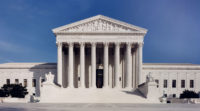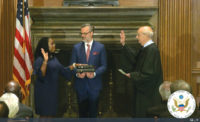The U.S. Supreme Court narrowed the federal government’s power to designate certain wetlands as federally protected in a May 25 opinion that rejected the Biden administration’s broader definition—with justices ruling that only permanent water bodies with at least a surface connection to waters considered to be “navigable” can be regulated under the U.S. Clean Water Act related to certain activities such as construction and energy development.
At issue in the case, Sackett v EPA, was whether federally protected waters, known as "Waters of the United States," should include tributaries or wetlands that may not have a surface connection to larger bodies of water but have a significant downstream biological effect on them.
The court, which called this “significant nexus” test “particularly implausible,” held that the U.S. Environmental Protection Agency has “no statutory basis to impose it.”
In the decision, all nine justices concurred that Idaho landowners Michael and Chantelle Sackett, in their second appeal before the court, should not be fined for building near wetlands that did not appear to have a direct surface connection to a larger body of water.
However, Brett Kavanaugh, joined by all three liberal justices—Sonya Sotomayor, Elena Kagan and Ketanji Brown Jackson—cautioned in a separate opinion that the majority had gone too far equating the term “adjacent to” with “adjoining to.” As a result, “some long-regulated adjacent wetlands [will] no longer be covered by the Clean Water Act, with significant repercussions for water quality and flood control throughout the United States,” he wrote.
The decision is a setback for environmental advocates and for the Biden Administration, which now must revise a regulatory framework to define Waters of the United States that was finalized late last year.
Larry Liebesman, a former U.S. Justice Dept. attorney and now a senior advisor for Dawson & Associates, says court rejection of the significant nexus test means that wetlands adjacent but separated by a berm or road from streams and their tributaries that were not traditionally navigable would not be federally regulated even if the wetlands provided water quality benefits to those waters.
As a result, a large percentage of U.S. wetlands would lose federal protection.
“The Sackett decision undoes a half-century of progress generated by the Clean Water Act," said Sam Sankar, vice president of programs at environmental group Earthjustice, in a statement. "Almost 90 million acres of formerly protected wetlands now face an existential threat from polluters and developers.” Earthjustice filed an amicus brief in the case in support of EPA.
Construction industry groups said the ruling would ease project regulatory uncertainty in some areas.
National Stone, Sand and Gravel Association CEO Michael Johnson said in a statement that the ruling is “a major step toward a more reasonable definition of WOTUS, which our members have struggled with for years and was exacerbated by the premature and confusing Biden administration rule.”
The group filed an amicus brief, along with the American Road and Transportation Builders Association, in support of the plaintiffs. “A clearer WOTUS definition is necessary for our industry to provide the materials needed to build and modernize our country’s infrastructure in an environmentally friendly manner,” Johnson added.






Post a comment to this article
Report Abusive Comment